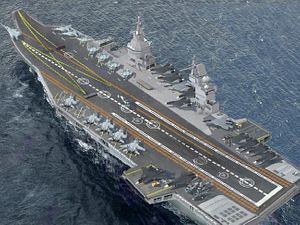As Franz reported last week, Russia has officially offered to construct a multirole nuclear aircraft carrier to fulfill India’s tender for INS Vishal. And although Franz notes that India will likely not avail itself of the Russian offer, it’s worth looking at some reasons why (and why not) it might make sense to go Russian.
There are several reasons to at least look at the Russian proposal with an open mind. Very few countries have the capacity to build a modern, nuclear aircraft carrier, and fewer have much of an interest in export. Russia and India have enjoyed a strong defense relationship for a long time, making them familiar with each other’s needs and specifications. In particular, Russia has played a major role in India’s naval aviation program, having modernized the INS Vikramaditya, and having supplied the Indian Navy with carrier aircraft. India has no experience with nuclear propulsion in a surface combat vessel, making domestic construction an iffy, long-range prospect. Finally, Russia has a ship design that, while still unproven, nevertheless has a pedigree that stretches back to the late Cold War.
Nevertheless, ordering a Russian aircraft carrier is not a good idea for India.
Russia has not constructed an aircraft carrier since the early 1990s; the closest it has come involved the modernization of the Vikramaditya (former Gorshkov) a process that went well over budget in both time and money. Although Russian shipbuilders undoubtedly learned a great deal from the modernization effort, Vikramaditya sailed for India almost three years ago, leaving human capital and infrastructure to deteriorate without immediate work.
Russia has not constructed a nuclear propelled surface combat vessel since the last of the Kirov-class battlecruisers, ships that for a long time endured significant reliability issues. Russia’s main experience with nuclear propulsion comes in its subsurface fleet; this experience is surely relevant, but with the construction of the Arihant-class, India has also begun to develop capabilities in this area.
Russia has not constructed a large surface combat vessel since the Kuznetsov; indeed, Russia has never constructed a ship of the size it has proposed to the Indians. Of course, no one except the Americans has, but France, Britain, and even India itself have more relevant recent experience.
Allowing Russia to build the aircraft carrier would raise immediate questions about how to integrate modern American carrier technology into the ship. The United States has discussed sharing EMALS catapult and other innovations with India; how the U.S. and India would manage the export control and intellectual property implications associated with a Russian bid is uncertain, at best.
Perhaps most importantly, if India relies on an export option for its next carrier, it risks losing the expertise and human capital that it has begun to develop with the construction of INS Vikrant. The United States continuously builds aircraft carriers not just for fun, but also in order to maintain a vibrant, capable shipbuilding workforce. India may never crank out CVs at the rate of the U.S., but maintaining industrial capacity is surely more important in the long-term than any gains the Indians may see from the Russian option.

































